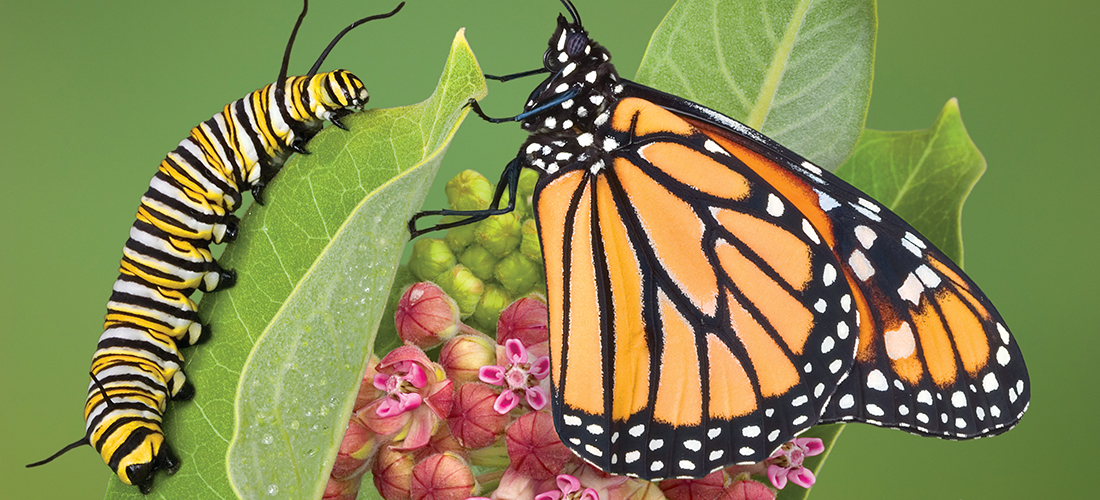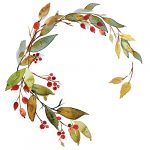
Of Monarchs and Milkweed
Can you give a butterfly a hand?
By Jan Leitschuh
The iconic, orange and black monarch butterflies are in shocking decline and could use a little help.
Luckily, our kitchen gardens — or any sunny patch of ground — can do more than grow a tomato. Since the life of the monarch butterfly is intimately entwined with that of the milkweed species, what if we were able to lend a little hand on our home turf?
Right now, the monarch butterflies are migrating southward through North Carolina on their awe-inspiring journey to their winter grounds in southern Mexico. But what will they eat? The only food a monarch caterpillar can consume is milkweed. Monarchs have lost an estimated 165 million acres of critical breeding habitat in the United States to herbicide spraying, deforestation and development in recent decades.
Sharp declines in milkweed populations in the agricultural Midwest have been reported. In the early ’90s, the increased spraying of glyphosate, or Roundup, following the introduction of crops genetically modified to withstand the herbicide, wiped out large tracts of perennial milkweed on farmland.
Do you have milkweed in your garden or yard? You could. Right now, and for the next couple of months, milkweed pods will be ripening and releasing their seeds. I gathered some fat pods from a Virginia mountain meadow six years ago and have had milkweed — and monarch caterpillars — ever since.
Throughout the United States, concerned gardeners are creating monarch-safe havens, little habitat “steppingstones” similar in intent to pollinator gardens, to recreate habitat for declining insect populations.
Though the migration is on now, you’ll be hard-pressed to spot the familiar monarch. In fact, seeing one is an Instagram-worthy moment these days. Staggering declines in these showy butterflies were reported in the 2000s. In Mexico, where the bulk of the migratory overwintering population returns to a specific area, the monarchs once occupied 45 acres at their peak in the mid-1990s. Recently, that population plunged to cover a mere 1.65 acres, according to the World Wildlife Fund.
The many troubles of the beautiful monarch butterfly are well documented. Severe and changing weather has damaged eggs and reduced hatch numbers. But most scientists concur that the monarch’s number one threat to survival is the dwindling number of wild milkweed plants available on which to lay their eggs.
This is where gardeners and landowners can fill in some of the gaps.
The story of today’s butterfly began with its great-grandparent leaving the forests of Mexico and heading for the milkweed of Texas. Adult monarchs consume plant nectar, but they lay their eggs exclusively on milkweed. The eggs hatch into the notable green-white-black caterpillars.
After feeding on milkweed leaves for two weeks (if they survive bird and insect predators, that is), they form a chrysalis on the underside of the milkweed leaf, eventually hatching into a bright orange butterfly — their numbers fanning out across the United States as far north as Canada. Given milkweed, another summer hatch ensues.
Finally, on the return trip — happening now — a third generation can hatch. This “super generation” mysteriously returns to the same Mexican forest its great-grandparents left from, though it had never been there. No one knows how this happens. The monarch is the only butterfly known to make this two-way migratory journey as birds do. There are much smaller populations that overwinter in Hawaii, Florida and California, too.
Back to your garden. There are several kinds of milkweed you could add that might suit. The entire milkweed family is catnip to butterflies of all sorts, and other native pollinators. Milkweeds establish large, deep root systems and prefer not to be transplanted. Some species are small and neat, some are large and coarse and are better suited to meadows, back of the border, under power lines and sunny edges of the property.
If you have a very neat, formal urban garden, seek out Asclepias tuberosa, or butterfly weed. Butterfly weed is a small, neat plant that does well in droughts, heat and Sandhills soil. The compact perennial displays flaming orange or cheerful, yellow blossoms. Establish several plants together to ensure sufficient food for hungry young caterpillars. Your local nursery can likely hook you up with a potted plant or three.
A little larger is whorled milkweed, (Asclepias verticillata), about 12-24-inches tall and wide. This white-flowered variety also does well in our dry summer conditions. You may have to order this from a specialty company such as the online retailer American Meadows, which ships potted plants. This unique company also has plenty of informative how-to information on its website.
Buying local? Sorrell’s Nursery in Dunn has a wide selection of native milkweeds that are organically grown — check out their Facebook page. MonarchWatch.Org is another excellent resource with leads on milkweed plants and seed.
Use care with the non-native, pretty, tropical milkweed, (Asclepias curassavica), say experts, as its long season of nectar could cause the monarchs to linger too long up north and get caught out by colder temps in fall. Some feel this is not an issue for Zone 7 and below. If used, experts suggest cutting this variety back in fall and winter.
Swamp milkweed (Asclepias incarnata) prefers moist areas, so if you have a nearby swamp, pond, lake or bog, check it out. Again, unless you have access to wild milkweed seed, you may have to order this.
The best-known milkweed is the common milkweed (Asclepias syriaca). Children enjoy tossing the fluff that carries each seed from this variety’s pod. In World War II, this fluff was used as a kapok substitute in life preservers — two bags of pods would fill one life jacket. This is the one I gathered as ripe seed pods from a sunny, unmown meadow and brought home to the Sandhills.
If you have a little space, or a “back of the border” that you could dedicate to a 36- 48-inch-tall plant, common milkweed produces tremendous lavender-pink blooms in June and is absolutely beloved by many pollinators. During the spring and fall monarch migrations, the abundant milkweed leaves of this plant provide food for a new generation of caterpillars.
One caution, though; your deeply rooted milkweed plot will grow slowly, so be sure to place it in a spot where it can quietly expand. If, after a few years, you want to contain its spread, common milkweed is easy to control by pulling, mowing or cutting.
You can even share with a neighbor who has more monarch caterpillars than available food — just stick a few cut milkweed stalks in a vase or bottle and pass it along. The caterpillars prefer the younger, more tender leaves rather than the leaves of podded stalks.
Besides the host plant milkweed, nectar plants that bloom at different times are needed for the monarch. The caterpillars eat the milkweed, but the parent butterflies need nectar.
Check out the North Carolina Wildlife Federation’s “Butterfly Highway.” Consider putting your butterfly/pollinator garden on the highway at: https://ncwf.org/habitat/butterfly-highway.
There are useful Facebook pages and groups dedicated to assisting monarchs and helping milkweed growers. Monarchs & Milkweed of Wake Forest is a good one, with a friendly community that reports sightings of monarchs, eggs, and caterpillars.
Monarchs, Milkweed and More is another Facebook group. Raleigh Area Monarchs and Milkweed is a third.
If gathering milkweed, select only a few pods, leaving the rest to spread from the mother plants. Look for a pod that has split, showing ripe, brown seeds. Pale seeds are not yet ripe. Or ask around among friends with farms and wilder spaces.
To start milkweed from seed, the easiest way is to emulate Mother Nature and plant them in the fall. I scattered seed across lightly disturbed soil and raked it in. Some separate the milkweed “fluff” from the seed, but I did not. Come spring, I had milkweed.
If you really want to start your seeds in the spring, American Meadows advises that you first break their dormancy with cold stratification. In the wild, says the online wildflower retailer, milkweed plants scatter their seeds quite late in the season. The coming cold would normally kill any seedlings that germinated right away. However, the seeds of milkweed (and other late-season flower plants) “are cleverly programmed to delay germination until after they’ve been exposed to winter’s cold, followed by gradually rising temperatures in springtime.” This adaptation is known as stratification.
So, if you have a little bit of space to offer a safe haven, you may become a critical stop-off for the struggling monarch species. PS
Jan Leitschuh is a local gardener, avid eater of fresh produce and co-founder of Sandhills Farm to Table.





